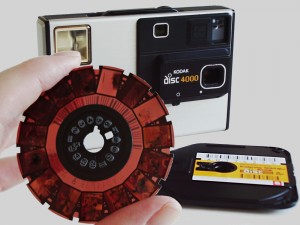I’ve heard it said that the best camera is the one you have with you. Sure, any picture is better than no picture, but with cell phones today many people don’t ever bother to bring a better camera, even if it’s small and fits in their pocket.

Obsolete Film Formats
The reasons 110 film, disc film and APS film (known as Kodak Advantix, Fuji Nexia, etc.) were created were all more or less the same – to allow the creation of smaller cameras that used more convenient film cartridges. Cartridges of various kinds allowed consumers to take pictures without worrying about advancing the film, and take the film out of the camera without having to rewind the film back into the film canister.
These formats were popular because 35mm film cameras were more complicated to use, and more prone to making mistakes (opening the camera before rewinding the film, for example). The biggest problem with these formats is that in order to make their cameras smaller, the size of the negatives are necessarily smaller than 35mm film. Smaller negatives means lower quality and higher grain.
The last format APS, was the highest quality of these formats, yet still lower than 35mm quality. APS film was introduced in 1996 and discontinued in 2004. The life of APS film was short because it was released just as digital cameras came into existence (the Apple Quicktake 100 was released in 1994). As digital cameras became more popular and cheaper, they surpassed the convenience factor of APS film, and there was almost no reason to buy APS film anymore.
It’s not so easy to get prints from these older formats. Your best best would be to get your old film scanned now. 110 and APS film can be scanned by many more places than disc film, so consider yourself lucky on two counts if your photos are not on disc film (bad quality and hard to scan).
Amazingly, the 35mm film cassette, introduced in 1934, is still in use. Additionally, the ‘full frame’ digital camera sensor is the same size as a single frame of 35mm film.
As good as cell phone cameras are…
For every person who says cell phone camera photos are bad, there is certainly someone who will show an amazing photo taken using their cell phone. Apple’s 1.24.14 ad which coincided with the 30th anniversary of the Mac, and was filmed on a single day around the globe using only iPhone 5s phones is amazing, and probably made some people think all they needed to be the next Spielberg was an iPhone 5s. Watching the Behind the Scenes video, however, should firmly bring everyone back down to earth as to how much skill, equipment (gyroscopic stabilization, microphones and lighting) and personnel were needed to make the video:
http://youtu.be/vslQm7IYME4
The truth is that many camera phones are capable of beautiful photos, when used in ideal situations. Ideal meaning the ideal amount and direction of light, not overly quick motion, time to focus, etc. The reality is of course usually much different. You might be able to touch to focus on many phones, but will you have time to do so before the photo you wanted disappears? Might you take the picture before the camera focuses properly? How many of you with state-of-the-art smart phones take blurry photos?
Besides the size of the sensor, the lack of optical zoom, the inability to focus quickly, etc. another big problem with cell phone cameras is the lack of a powerful flash. There just isn’t a very good range possibly from such a small flash.
Parallel History
For all of the children of the 70s, 80s, and 90s whose parents chose the convenience of cartridge film formats, whose childhoods are documented in grainy photographs that are extremely difficult to print or scan today, the children growing up today will in a somewhat parallel fashion, feel your pain. While there are likely to be many more photos taken on parents’ cell phones today than on film cameras of yesteryear, and while digital files can last forever (although back up people – a friend of mine just lost 8 years of photos in a hard drive failure), there are going to be a lot of photos taken on cell phones that are blurry and grainy (technically it’s noisy, not grainy, but let’s just call it grainy), and generally just bad quality.
How many times did you think you got a great shot on your camera just to realize when reviewing it later that it was blurry, or the light was so bad that the image came out super grainy (sometimes just as bad as disc film)? How many times have you just copied your photos to a folder somewhere not to review them for years, and then find out how grainy and/or blurry the photos are?

I was reminded of these facts recently at a presentation done with the first graders in my daughter’s school. Imagine a massive dimly-lit rented theater space with hundreds of parents and grandparents seated stadium style, shooting photos from a considerable distance from the stage, their child/grandchild a little dot in the frame of their cell phone or tablet. Almost everyone at this recent event was shooting photos with their phones, with a sprinkling of tablets, a small number of compact digital cameras, and a handful, maybe, of DSLRs showing up. Since cell phone cameras don’t have optical zoom, when those parents shot photos of their children they digitally zoomed to get the picture of their child, further pixelating the images. Out of the thousands, maybe tens of thousands, of images generated in that single event by all of those cell phones, how many images are actually decent quality? My photo, from the mentioned event, was taken near the front row. Imagine what the photos from the parents 20 rows back look like.
Basically, it’s been over 40 years since film cartridge formats were introduced, and somehow we’re still spitting out grainy photos for convenience’s sake.
p.s. I did take the photo above, but just to record the GPS data to sync later with my photos taken on my dedicated camera. It doesn’t have GPS, but I can sync the GPS from the above photo into the photos from my other camera via software (I use MyTracks for this purpose).
Just for fun
Just for fun, here’s an advertisement for Kodak disc film from what must be 1982, when the film was introduced: